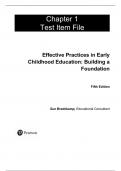Chapter 1
Test Item File
R
U
Effective Practices in Early
SE
Childhood Education: Building a
Foundation
IS
O
N
Fifth Edition
N
O
C
ED
Sue Bredekamp, Educational Consultant
M
, Table of Contents
Chapter 1: Continuity and Change in Early Childhood Education 1
Learning Outcome Quizzes 1
Application Exercises 19
Test Items 23
Test Answer Key 31
R
U
SE
IS
O
N
N
O
C
ED
M
iv
Copyright © 2024, 2019, 2015 Pearson Education, Inc. All Rights Reserved.
, Chapter 1: Continuity and Change in Early Childhood
Education
Chapter 1 Learning Outcome Quizzes
Learning Objective 1.1: Describe early childhood education and the diverse settings in
which children are cared for and educated.
[Q1]
Early childhood education serves children of various ages in diverse settings. What is
R
that age range and where are children served?
1. Early childhood education serves children from birth through age eight in child care
U
centers and homes, public and private preschools, and primary grade schools.
[correct]
SE
2. Early childhood education serves all children in child care programs, regardless of
age.
3. Early childhood education serves children from birth through age five in child care
IS
centers and homes, public and private preschool, Head Start, and prekindergarten
programs.
O
4. Early childhood education serves 4- to 8-year-old children from prekindergarten
through third grade.
N
[Feedback for Correct Answer 1]
N
Early childhood education is defined as programs and services for children from birth
through age eight in settings that include child care centers and homes, public and
O
private preschools, Head Start, and primary grade schools.
[Feedback for Answer Choice 2]
C
Early childhood education encompasses child care centers and family child homes that
ED
serve children from birth through age 8, but does not include all children regardless of
age.
[Feedback for Answer Choice 3]
M
Early childhood education is defined as programs and services for children starting at
birth, but the age range does not end at five years.
[Feedback for Answer Choice 4]
Early childhood education is defined as programs and services for children from birth
through age eight including but not limited to prekindergarten through third grade.
[Q2]
What services do Head Start programs provide?
1
Copyright © 2024, 2019, 2015 Pearson Education, Inc. All Rights Reserved.
, 1. Head Start provides comprehensive services including educational, health,
nutritional, social, and other services to the nation’s all children and families
regardless of social-economic level.
2. Head Start provides health, nutrition, and social services to infants and toddlers, and
their families.
3. Head Start provides comprehensive services including educational, health,
nutritional, social, and other services to children and their families whose incomes
fall below the federal poverty level. [correct]
4. Head Start provides educational, health, nutritional, social, and other services to
elementary school children and their families.
R
[Feedback for Answer Choice 1]
U
Head Start is a federally funded program that provides education for young children
whose family incomes fall below the federal poverty level.
SE
[Feedback for Answer Choice 2]
Early Head Start, not Head Start, provides comprehensive services including
educational, health, nutritional, social, and other services to pregnant mothers, infants,
toddlers, and their families.
[Feedback for Correct Answer 3]
IS
O
Head Start provides educational, health, nutritional, social, and other services for
children and families whose incomes fall below the official poverty level. Head Start
N
serves 3- through 5-year-olds and Early Head Start serves pregnant mothers, infants
and toddlers, and their families.
N
[Feedback for Answer Choice 4]
O
Head Start does not provide services to elementary school children and their families.
C
[Q3]
Describe access to early education.
ED
1. Children who are living in poverty are less likely to attend high-quality early
childhood programs than children from higher-income families. [correct]
2. Head Start programs have sufficient funding to serve all income-eligible children and
M
their families.
3. Families with the highest income face the greatest hurdle because they are not
eligible for subsidized programs.
4. Rural communities have greater access to high-quality child care than urban or
suburban areas.
[Feedback for Correct Answer 1]
Children living in poverty have less access to high-quality early childhood programs
than children from higher-income families.
2
Copyright © 2024, 2019, 2015 Pearson Education, Inc. All Rights Reserved.




